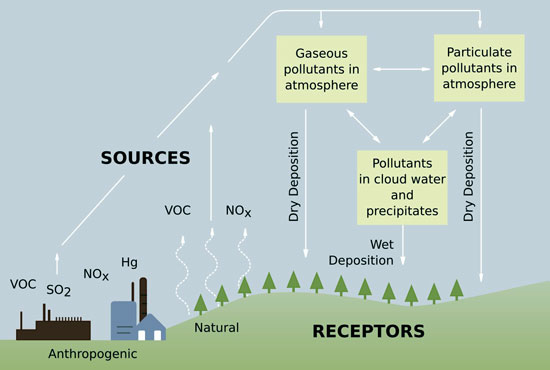

Acid rain is a broad term used to describe a precipitation, as rain, snow, or sleet, containing relatively high concentrations of acid-forming chemicals, as the pollutants from coal smoke, chemical manufacturing, and smelting, that have been released into the atmosphere and combined with water vapor: harmful to the environment.
Acid rain is a generic term that includes all precipitation with high acid content. This precipitation, when introduced into groundwater sources, lakes, rivers, streams, ponds, etc., eventually produces an inhospitable environment for aquatic plant and animal life. Acid rain can also damage crops and buildings
Acid rain is produced when chemical pollutants interact with sunlight to produce sulfuric and nitric acids. These acids combine with moisture in the air (groundwater sources that have evaporated and condensed) to produce acid rain, snow, etc. Since there is usually more sunlight in the summer months, acid rain tends to be more acidic in the summer.
Acid rain is the result of industrial pollution, which causes rainwater to carry small quantities of acidic compounds such as sulphuric and nitric acid. Contaminated rainwater can upset the chemical balance rivers and lakes, killing fish and other organisms and also damage plants, trees and buildings.
Effects of acid rain :
Acids can affect receiving systems in a variety of ways, some good, others bad. Addition of nitrate to ecosystems deficient in nitrogen can lead to enhanced biologic productivity. The benefits, however, may be offset by toxic effects associated with the release of aluminum and magnesium from clay minerals if the pH of soils falls below about 5.5. Leaching of metals from soils and sediments also can have adverse effects on aquatic systems. Fish may be killed by aluminum even under conditions where the pH is considered otherwise benign. Given the current rates of acid deposition, the pH of a number of lakes in the northeastern United States and in southeastern Canada is expected to average 4.2 to 4.8, with occasional depressions to near 3.8 during periods of snowmelt or heavy rain. Most fish species and almost all mollusks perish if the pH falls below 4.8; planktonic communities are simplified in this case, dominated by a few acid-tolerant taxa. Adverse effects of acid precipitation are most obvious for lakes, and it is not surprising that this aspect of the issue has received the most attention in the press. The effects on the terrestrial biosphere are more ambiguous. It appears that elevated levels of ozone in the troposphere may pose a more serious hazard for plant life even at locations removed from major industrial sites. Effects in this case, for a variety of agronomic and forest species, include foliar injury and significant reduction in growth and yield.
In summary, there are deficiencies in current scientific understanding of acid rain, both in its atmospheric and biospheric dimensions. Uncertainties can be removed or reduced by a suitably directed research program. It is clear that the chemistry of the troposphere, both polluted and clean, should receive attention in this effort.
How Acid Rain Affects The Environment :
Acid rain is an extremely destructive form of pollution, and the environment suffers from its effects.  Forests, trees, lakes, animals, and plants suffer from acid rain.
Forests, trees, lakes, animals, and plants suffer from acid rain.
Trees are an extremely important natural resource. They provide timber, regulate local climate, and forests are homes to wildlife. Acid rain can make trees lose their leaves or needles- they turn brown and fall off. Trees can also suffer from stunted growth; and have damaged bark and leaves, which makes them vulnerable to weather, disease, and insects. All of this happens partly because of direct contact between trees and acid rain, but it also happens when trees absorb soil that has come into contact with acid rain. The soil poisons the tree with toxic substances that the rain has deposited into it.
Lakes are also damaged by acid rain. A lake polluted by acid rain will support only the hardiest species. Fish die off, and that removes the main source of food for birds; also contaminating the lake water. Also, birds can die from eating "toxic" fish and insects. Acid rain can even kill fish before they are born. Acid rain hits the lakes mostly in the springtime, when fish lay their eggs. The eggs come into contact with the acid, and the entire generation can be killed. Fish usually die only when the acid level of a lake is high; when it is lower, they can become sick, suffer stunted growth, or lose their ability to reproduce.
How Acid Rain Affects People :
Humans can become seriously ill, and can even die from the effects of acid rain. One of the major problems that acid rain can cause in a human being is respiratory problems. Many can find it difficult to breathe, especially asthma patients. Asthma, along with dry coughs, headaches, and throat irritations can be caused by the sulfur dioxides and nitrogen oxides from acid rain.
Acid rain can be absorbed by both plants (through soil and/or direct contact) and animals (from things they eat and/or direct contact). When humans eat these plants or animals, the toxins inside of their meals can affect them. Brain damage, kidney problems, and Alzheimer's disease has been linked to people eating "toxic" animals/plants.
Looking for something? Ask Google.
Try out the other sections